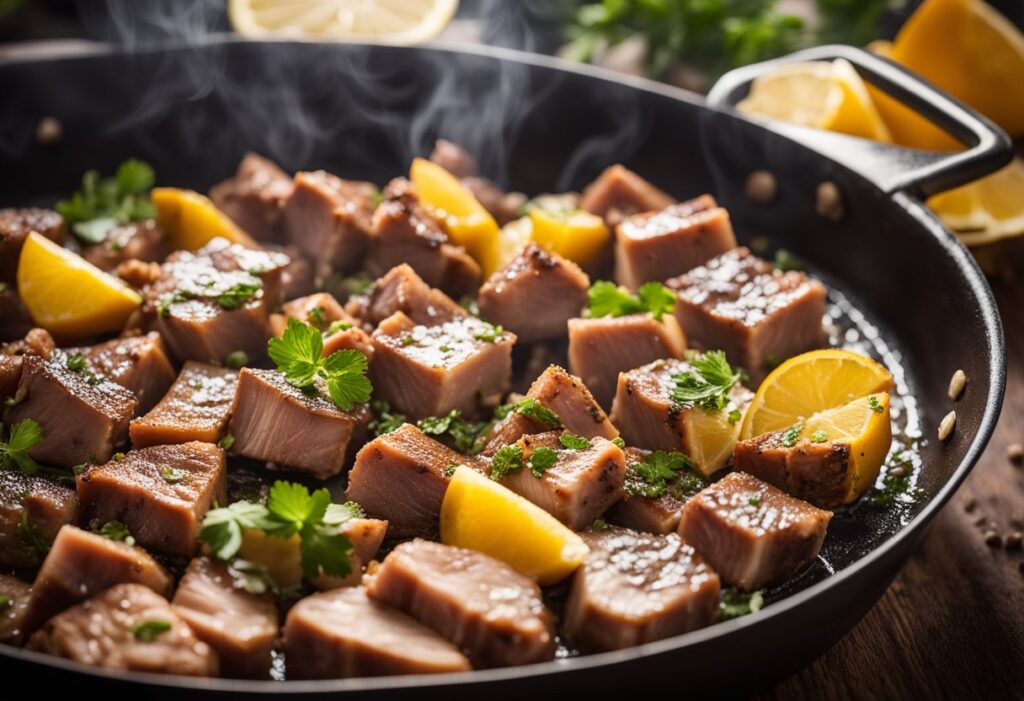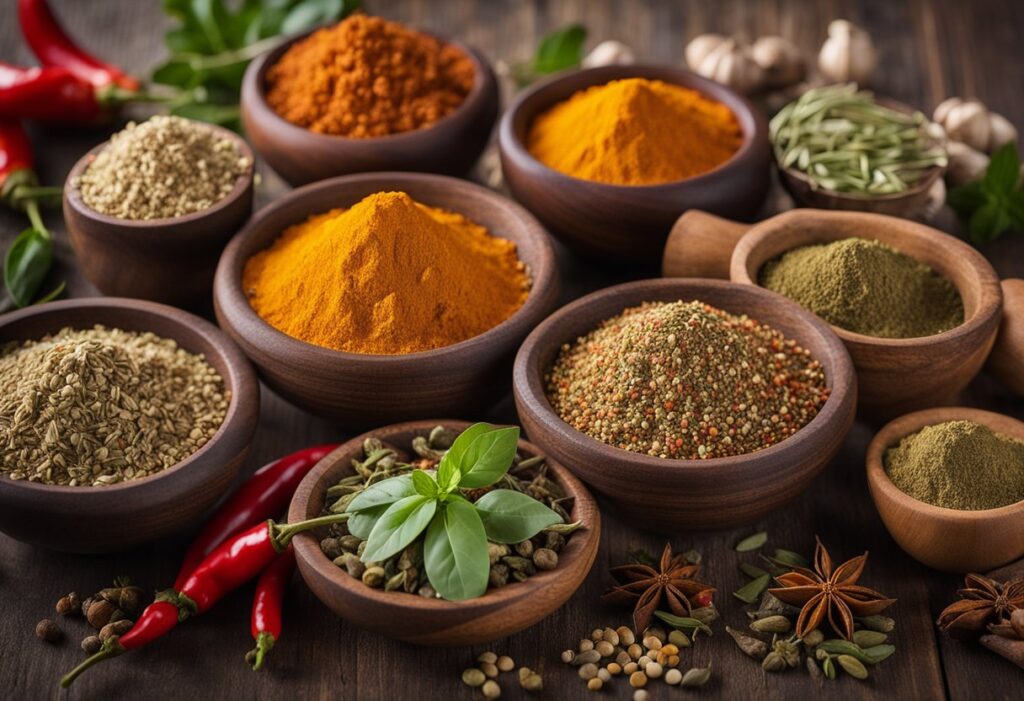Carnitas seasoning is a flavorful blend of spices and herbs that is commonly used in Mexican cuisine. This seasoning is used to add a rich and savory flavor to pork, which is then slow-cooked until it becomes tender and juicy. The result is a delicious and satisfying dish that is perfect for any occasion.

One of the key ingredients in carnitas seasoning is cumin, which adds a warm and earthy flavor to the dish. Other common ingredients include chili powder, oregano, garlic powder, and salt. These spices work together to create a complex and well-rounded flavor that is both spicy and savory.
Carnitas seasoning is a versatile ingredient that can be used in a variety of dishes. It can be used to season other types of meat, such as chicken or beef, or it can be used to add flavor to vegetables or grains. Whether you are looking to make a traditional Mexican dish or you simply want to add some flavor to your cooking, carnitas seasoning is a great choice.
History of Carnitas Seasoning

Carnitas seasoning has a rich history that dates back to the Aztecs. It was a popular dish among the indigenous people of Mexico, who used it as a way to preserve meat. The word “carnitas” translates to “little meats” in Spanish, and the dish is typically made with pork that has been slow-cooked in lard until it is tender and juicy.
Over time, different regions of Mexico developed their own unique blends of spices and herbs to flavor their carnitas. Some popular ingredients include garlic, cumin, oregano, and chili powder. These seasonings are often mixed together to create a dry rub that is applied to the pork before cooking, or added to the lard during the cooking process.
Today, carnitas seasoning is enjoyed all over the world and is a staple in many Mexican restaurants. It is often used to flavor not only pork, but also chicken, beef, and even vegetables. Whether it’s served in tacos, burritos, or on its own, carnitas seasoning adds a delicious and authentic flavor to any dish.
Essential Ingredients
When it comes to making delicious carnitas, using the right seasoning is crucial. While there are many different variations of carnitas seasoning, there are a few essential ingredients that are commonly used to create the perfect blend of flavors.
Pork Preparation
The first step in making great carnitas is to start with the right cut of pork. Traditionally, pork shoulder or butt is used for carnitas because it has the perfect balance of fat and meat. The pork should be cut into large chunks and seasoned with salt and pepper before cooking.
Herbs and Spices
The key to great carnitas seasoning is a blend of herbs and spices that complement the pork without overpowering it. Some of the most common herbs and spices used in carnitas seasoning include cumin, oregano, garlic powder, and chili powder. These ingredients can be combined in different ratios to create a unique flavor profile.
Citrus and Acids
In addition to herbs and spices, citrus and acids are also important components of carnitas seasoning. Lime juice is often used to add a bright, tangy flavor to the meat, while vinegar or orange juice can be used to tenderize the pork and balance out the richness of the meat.
Overall, the key to making great carnitas seasoning is to use high-quality ingredients and balance the flavors carefully. With the right blend of herbs, spices, and acids, anyone can create delicious carnitas that are sure to please.
Regional Variations
Mexican Traditional
Carnitas seasoning is a crucial ingredient in traditional Mexican cuisine. The recipe for carnitas seasoning varies depending on the region, but it typically includes a blend of spices such as cumin, oregano, garlic, and chili powder. Some regions also add other spices such as cinnamon, allspice, and cloves.
In central Mexico, carnitas seasoning is often made with a combination of cumin, garlic, and chili powder. In the Yucatan Peninsula, annatto seeds are added to give the seasoning a distinct red color and a slightly sweet flavor. In the northern regions of Mexico, carnitas seasoning is often made with a blend of cumin, garlic, and paprika.
Tex-Mex Influence
Tex-Mex cuisine has had a significant influence on carnitas seasoning in the United States. Tex-Mex carnitas seasoning typically includes a blend of spices such as cumin, chili powder, garlic powder, onion powder, and paprika. Some recipes also call for additional spices such as coriander, cayenne pepper, and black pepper.
Tex-Mex carnitas seasoning is often used in dishes such as tacos, burritos, and enchiladas. It has a slightly different flavor profile than traditional Mexican carnitas seasoning, with a stronger emphasis on chili powder and cumin.
Modern Fusion
In recent years, chefs have been experimenting with new and innovative ways to use carnitas seasoning. Modern fusion cuisine often incorporates a variety of flavors and ingredients from different cultures, resulting in unique and exciting flavor combinations.
Some modern fusion carnitas seasoning recipes include ingredients such as ginger, lemongrass, and soy sauce. Others incorporate spices such as turmeric, cardamom, and fenugreek. These new and exciting flavor combinations are a testament to the versatility of carnitas seasoning and its ability to adapt to different culinary traditions.
Cooking Techniques
Slow Cooking Methods
Slow cooking is the most traditional way to cook carnitas. It involves simmering the seasoned pork in a pot or slow cooker for several hours until it becomes tender and juicy. This method allows the meat to absorb the flavors of the seasoning and results in a melt-in-your-mouth texture. To achieve the best results, use a cut of pork with a higher fat content, such as shoulder or butt.
Oven Roasting
Oven roasting is a popular method for making carnitas because it creates a crispy exterior while keeping the meat tender on the inside. To achieve this, place the seasoned pork in a baking dish and roast it in the oven at a high temperature until it becomes golden brown and crispy. This method works well for larger cuts of meat and is a great option for feeding a crowd.
Grilling
Grilling is a great way to cook carnitas for those who prefer a smoky flavor. To grill carnitas, season the pork and grill it over medium-high heat until it is cooked through and slightly charred on the outside. This method works well for smaller cuts of meat and is perfect for summer barbecues.
No matter which cooking method you choose, it is important to ensure that the pork is cooked to a safe internal temperature of 145°F to prevent the risk of foodborne illness. Once cooked, let the meat rest for a few minutes before shredding it with a fork and serving it with your favorite toppings.
Application of Carnitas Seasoning
Carnitas seasoning is a versatile spice blend that can be used in various ways to enhance the flavor of meat dishes. Here are some common applications of carnitas seasoning:
Marinades
Carnitas seasoning can be used as a marinade for meats such as pork, chicken, and beef. To make a marinade, mix the carnitas seasoning with oil, vinegar, and any other desired flavorings. Marinate the meat for at least 30 minutes before cooking to allow the flavors to penetrate the meat.
Dry Rubs
Carnitas seasoning can also be used as a dry rub for meats. To make a dry rub, simply rub the seasoning onto the meat before cooking. This method is ideal for grilling, roasting, or smoking meats.
Finishing Touches
Carnitas seasoning can also be used as a finishing touch to add flavor to cooked meats. Sprinkle the seasoning onto the meat just before serving to enhance the flavor and aroma.
When using carnitas seasoning, it is important to keep in mind that a little goes a long way. Start with a small amount and adjust to taste. Also, be sure to check the ingredients of the seasoning to ensure that it does not contain any allergens or ingredients that may be harmful to certain individuals.
Overall, carnitas seasoning is a great way to add flavor and depth to meat dishes. Whether used as a marinade, dry rub, or finishing touch, this versatile spice blend is sure to please.
Pairings and Serving Suggestions
Traditional Sides
Carnitas seasoning is a versatile spice blend that pairs well with a variety of traditional Mexican sides. Some popular options include rice and beans, guacamole, pico de gallo, and fresh salsa. These sides complement the rich and savory flavors of the carnitas seasoning and help balance out the dish. For a more substantial meal, consider serving the carnitas with a side of warm tortillas for guests to make their own tacos.
Condiments
Condiments are an essential part of any Mexican meal and can take the flavor of carnitas to the next level. Some popular options include sour cream, lime wedges, and sliced jalapenos. For a spicy kick, consider adding a few dashes of hot sauce or a sprinkle of chili flakes to the carnitas. If you’re looking for a sweet and tangy flavor, try adding a drizzle of honey or a squeeze of fresh orange juice.
Beverage Pairings
When it comes to beverage pairings, there are a few options that work well with carnitas. For a refreshing and light option, consider serving the carnitas with a cold beer or a glass of white wine. If you prefer something non-alcoholic, try serving the carnitas with a glass of cold iced tea or freshly squeezed lemonade. For a more traditional Mexican beverage, consider serving the carnitas with a glass of horchata, a sweet and creamy rice-based drink.
DIY Carnitas Seasoning Mix
For those who prefer to make their own seasoning mixes, creating a DIY carnitas seasoning mix is a great way to add a personal touch to their dishes. The following recipe can be adjusted to suit personal preferences and tastes.
Ingredients
- 1 tablespoon chili powder
- 1 tablespoon smoked paprika
- 1 tablespoon ground cumin
- 1 tablespoon garlic powder
- 1 tablespoon onion powder
- 1 teaspoon salt
- 1 teaspoon black pepper
Instructions
- In a small bowl, combine all ingredients and mix well.
- Store in an airtight container in a cool, dry place for up to 6 months.
This DIY carnitas seasoning mix is a simple yet flavorful blend of spices that can be used to season pork for carnitas or any other dish. By making your own seasoning mix, you can adjust the levels of each spice to your liking and ensure that your dish is perfectly seasoned.
When using this seasoning mix, it is recommended to rub it all over the pork before cooking and letting it marinate for at least an hour in the refrigerator. This will allow the flavors to penetrate the meat and create a delicious, flavorful dish.
Overall, making your own DIY carnitas seasoning mix is a great way to add a personal touch to your cooking and create a delicious, flavorful dish that everyone will enjoy.
Storage and Shelf Life
Carnitas seasoning should be stored in a cool, dry place away from direct sunlight. Exposure to air, moisture, and heat can cause the spices to lose their flavor and potency over time.
It is recommended to store the seasoning in an airtight container to help preserve its freshness. Glass jars or plastic containers with tight-fitting lids are good options for storage.
The shelf life of carnitas seasoning can vary depending on the quality of the ingredients used and the storage conditions. Generally, properly stored carnitas seassoning can last for up to 6 months to a year.
To ensure the best quality and flavor, it’s recommended to use the seasoning within the first 6 months of purchase. After that, the spices may start to lose their potency and flavor.
It’s important to check the seasoning for any signs of spoilage or contamination before using it. If the seasoning has an off smell, mold, or discoloration, it should be discarded immediately.
Overall, proper storage and timely use of carnitas seasoning can help maintain its quality and flavor for longer periods.
Nutritional Information
When it comes to carnitas seasoning, it is important to be aware of its nutritional information. Here are some key facts to keep in mind:
- A tablespoon (7g) of typical carnitas seasoning contains around 25 calories.
- Most of the calories come from carbohydrates, with around 5g of carbs per tablespoon.
- Carnitas seasoning is generally low in fat, with less than 1g of fat per tablespoon.
- It is also low in protein, with less than 1g of protein per tablespoon.
- Some varieties of carnitas seassoning may contain added sugars and sodium, so it is important to read the label carefully.
Overall, carnitas seassoning can be a flavorful addition to your meals, but it is important to use it in moderation and be mindful of its nutritional content.

